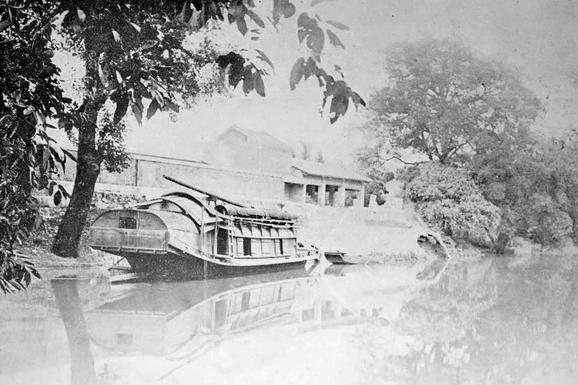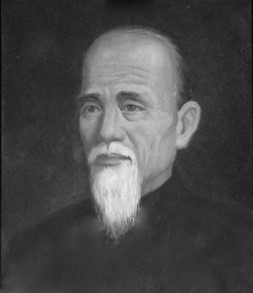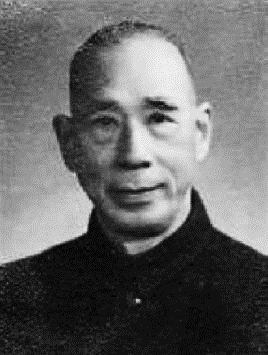Fojia Quan (佛家拳), was practiced in the Lingnan area in the 17-1800’s and later was later to become incorporated into a number of different styles. The important element to the Fut Gar style are long powerful whipping & swinging strikes that are able to use and generate full body power. Fut Gar deploys circular continuous palm and fist hand strikes with agile and intelligent footwork.
Qingyun Temple (庆云寺)

The Qingyun temple took nine years to build and was completed in 1636 located in the Dinghu Mountains outside Zhaoqing City. The Dinghu mountains was home to a primeval forest and as such an ideal point of convergence for Buddhist pilgrims. After the fall of the Ming dynasty, there were many Han Chinese that could not accept the notion of being governed by the Manchurian Imperial house, and many secret societies and underground movements were initiated that fostered the notion of a return of the Ming. Such societies regularly used temples as decoys and allies in their activities, whilst other times those avoiding or wanted by Imperial officers for crimes, would hide and convert to monks in recluse temples. It is likely under this scenario that in the late 1700/early 1800’s ‘martial ‘ (ex fighters converted) monks may have resided in Qingyun Temple. Wu Dechao (吴德超, 1726-1812), from also later known as Wan Yunlong (万云龙) and as Hongyi (洪義) amongst many different names was a prominent figure in the Tiandi Hui and often considered an ex Shaolin Fighter and the source of much martial elements as much as political aspects to the Tiandihui. Records show that between 1761 and 1789, he taught many followers and disciples. For lay followers often obtaining skills in such temples they would refer to the styles as Fojia (Buddhist family) in respect to their origins from the Buddhist temples, in some cases especially as the Qing government in the early days had an affiliation to the Lama Buddhism (popular in the Western and distant North parts of China such as Tibet, Qinghai and Mongolia which were under the imperial control so as to avoid conflict there was good allowance for Lamaism), the use of Lama was also applied potentially and thereby the instance of Lama Pai (喇嘛派). In any case the styles derived from Qingyun are focused on the same basic traits and combat principles (there is no association to Tibet at all). In general the boxing methods of the times were variants of the combat methods within the Hongmen Societies (Small Sword Society, Heaven and Earth Society) and later were involved in other rebellions (such as the Taiping Tianguo in the 1800’s).
Wang Yinlin (王隐林, 1801-1882)

Known as the best of the Ten Tigers of Guangdong, Wang Yinlin (c. Wong Yanlum) first studied with his father, Wang Ping (a Hung Kuen practitioner) and later studied Fojia (c. Fut Gar, sometimes called Lama Pai) with a monk from the Qingyun Temple, Dinghu Mountain in Guangdong for almost a decade. He later roamed the county (in the North, Shanxi) whilst working as a Security Logistics Escort, gaining much practical experiences, he also became involved in revolutionary movements, gained further martial skills and a great reputation as the ‘Da Xia’ (great hero) and thus some of his students later called the style Xia Jia (c. Hap Gar) in his honor.
There is a story or legend that says that when Wang Yinlin returned to Guangdong, he set up a stage for challengers so that he could prove his martial arts effectiveness, and that for 18 days, over 150 of the region’s best fighters were defeated. As a result of that feat, he was ranked by some, as the best among the famed Ten Tigers of Guangdong and considered the best fighter in Southern China.
His students included Wang Hanrong (王汉荣), Wang Lun (王敬初), Cai Yigong, Wang Linkai, Chen Yin, Zhu Ziyao, Zhou Xiangyun and Pan Jian. Wang Lun and Wang Hanrong called the style Xiajia (Hap Ga, 侠家拳), Wu Zhaozhong (c. Ng Siuchung, 吴肇钟,1887-1967) student of Zhu Ziyao, called it Baihe Pai (白鹤派 c. Pak Hok Pai) and Cai Yigong 蔡懿恭 called it Lama Pai (喇嘛派).
Chen Xiang (陳享1806-1875)

Chen Xiang was from Jingmei village, Xinhui county, Guangdong province and from the age of 5 studied Fut Gar with his uncle Chen Yuanhu (陈远护), who had studied with M. Du Zhang from Qingyun Temple on Dinghu Mountain. His uncle used to teach Qingyun Fut Gar in Kengtou village and Hui Cheng. By the age of 17, Chen Xiang taught on behalf of his uncle. Later, at the recommendation of his uncle, Chen Xiang studied further methods with Li Yousan (李友山) of the Xinhui Li Family style for 5 years. Later he encountered Cai Fu (蔡褔), a practitioner that resided on Luofu Mt. After combining his knowledge from the three teachers, Chan Heung established a school known as Hung Sing Gwoon and a TCM clinic – Wing Sing Tong (today better known as Choy Li Fut, 蔡李佛 ). Chan Heung also taught in distant places for the Overseas Chinese Association, such as in Singapore & Malaysia. Chen Xiang had lived during a very unstable time and had many experiences as a result. When the first Opium wars broke out (1839-42) Chen Xiang joined the fight against the British trade groups.
When the Taiping Rebellion rose in 1850’s many of Chen Xiang’s students joined the rebellion forces against the corrupt Manchu rule, after its fall in 1864, Chen Xiang left (some suspect overseas to HK, Malaysia/Singapore) and returned only in 1867. During that time the various branches fully developed Choy Li Fut system and many of the forms and keys within the style were based on matters of rebellion as much as hidden Han cultural codes. The majority of the Southern revolutionary groups formed a part of the Hung Mun as did the Choy Li Fut groups, students of Chen Xiang included Chen Dianyou, Chen Dayi, Chen Diancheng, Cen Dianhui and so forth that spread across different parts of Guangdong. Hi students established and spread the martial arts under the guise of “Hong Sheng” Martial Schools (洪聖武馆) which had up to 44 branches across Guangdong and Guangxi. His key successors were his sons, Chen En’bo and Chen Guanbo. Chen En’bo the eldest son continued his father’s support of rebellion legacy, as two of his students helped the Tongmen Hui of Sun Yatsen.
Huang Xiaoxia (黄啸侠, c. Wong Siuhap, 1900-1981)

Huang Xiaoxia (黄啸侠, 1900-1981), was born in the Panyu County of Guangdong province. Since a young age he loved practicing martial arts and was taught in his youth by many well known masters at the time including Cheng Hua (程华 Hung Kuen), Chen Guanbo (陳官伯, Chan Koon Pak, second son of Chen Xiang, Founder of Choy Li Fut), Li En (李恩 Choy Li Fut, student of founder Chan Heung who took over his studies after Chan Koon Pak passed away). He was a diligent and capable student and absorbed much from his masters. Later, Huang Xiaoxia joined the Guangzhou Jingwu Association and studied arts from the North from such notables as Zhao Lianhe, Chen Shi and Wang Fenggang. He later became a disciple of the Master Sun Yunfeng (Northern Luohan Men) studying for many years. M. Huang continued absorbing from different martial arts all his life, including western boxing as well. M.Huang learnt directly from more than 10 famous teachers and nicknamed the “iron-armed mandarin duck”.
When the five special teachers were sent south (also known as the five Northern tigers traveling South), these included Wan Laisheng, Gu Ruzhang, Fu Zhensong, Li Xianwu and Huang Xiaoxia (even though Huang Xiaoxia was from the South!, but his arts through Sun Yunfeng and Jingwu were of the North). From 1928-1937 Huang was the instructor for the Guangzhou Natioanl Sports association within Dai Fut Temple (大佛寺) and also the instructor for a few high schools in the area. In the 1930’s the Sino-japanese war broke out and Huang Xiaoxia had a strong sense of helping his nation, further to many incidents and confrontations he also, as an example applied his broadsword skills to train coaches that could help people defend themselves. His patriotism noted in records of the time. In 1938, Huang went to Hong Kong to become instructor for a few schools there including the Jingwu Association. He returned to Guangzhou after the liberation of China in 1949, where he continued his practice and teaching at many institutions across the area. After an illustrious life of learning many styles, tribulations during war and numerous teaching posts, Huang Xiaoxia developed a unique synthesis of his styles, which became known as “Huang Xiaoxia Quan Fa” (Huang’s Boxing Methods) or Luohan Men depending on the period of time. His techniques passed on by his various students some of the earlier materials, some of the Luohan school whilst others of his synthesized styles. Huang Xiaoxia was one of the great masters of Chinese boxing in Guangzhou in the 20th century.
System of Qingyun Fojia Quan
The foundations of Fut Gar are based on the 12 basics. In Buddhism, 12 is symbolic of the Twelve links of dependent origination. The twelve links are Ignorance, Formation, Consciousness, Skandhas, Ayatanas, Contact, Sensation, Craving, Grasping, Becoming, Rebirth, Old Age and death. These being considered as the cycle which binds people into the wheel of life, death and rebirth in accordance to Buddhist teachings. Together there are 9 focused methods (3 bodies of Dharmakaya, Sambhogakaya & Nirmanakaya, 3 roots of Blessing, Methods and Activity and 3 universal truths of Buddhism ), thus multiples of twelve equal 108 (which is also an important number in Buddhism).
| 12 Strikes 12 Palms 12 Stances | 12 Points 12 Claws/Grabs 12 Elbows/knees | 12 Kicks 12 throws 12 Steps/Footwork |

Empty Hand Forms
There are eighteen (18) major empty hand forms within the Qingyun Fut Gar system, which encompass a huge array of combat-oriented techniques enhanced by masters in each generation. Each set emphasizes specific combat principles and strategies, as well as techniques and methods, Some of the longer sets have two parts, often nicknamed small/big or upper/lower. In general, it is characterized by steady yet fast flexible footwork, the legs are sharp and fast, the techniques are comprehensive, the strength is abundant emphasizing simplicity, conciseness, practicality, and speed.
| 十字拳 Intersectional Cross Fist 连手拳 Linked Hands Boxing 太平拳 Greater Peace Fist 蝴蝶掌 Butterfly Palms 伏虎拳Tiger Taming Fist 梅花拳 Plum Blossom Fist | 降龙掌 Dragon Subduing Palms 罗汉拳 Arhat Fist 练步拳 Practice stepping fist 鐡箭拳 Iron Arrow Fist 天罡拳 Heavenly Constellations Fist 虎鹤拳 Tiger Crane Fists | 洪门拳 Hong Society Boxing 黑虎拳 Black Tiger Boxing 八卦拳 8 Trigrams Boxing 白毛拳 White Hair Fist 太祖拳 Great Ancestor Boxing 金刚拳 Dharma Guardians Boxing |
Cultivation Exercises
| 六合功 Six Harmonies Exercise 罗汉功 Luohan Exercise | 白鹤功 White Crane Exercise 佛家掌 Buddha Pam | 棉里针 Needle in Cotton 易筋功 Changing tendons |
Weapons
| 二郎棍 Erlang Staff 齊眉棍 Eyebrow height staff 龙虎棍 Dragon Tiger Staff 七星刀 Seven Star Sabre 步战单刀 Military Saber 断门刀 Breaking Saber | 青龙剑 Green Dragon Sword 连环剑 Continuous Sword 梅花双刀 Double Saber 罗家枪 Luo family Spear 九点枪 9 points Spear 钩廉枪 Hook Spear | 伏虎大耙 Tiger Taming Trident 春秋大関刀 Kwan Kung Long knife 九環大刀 9 Rings Long handled Knife 梅花槍 Plum Blossom Spear 拐杖 Crutches 三节棍 Three Sectional Staff |
